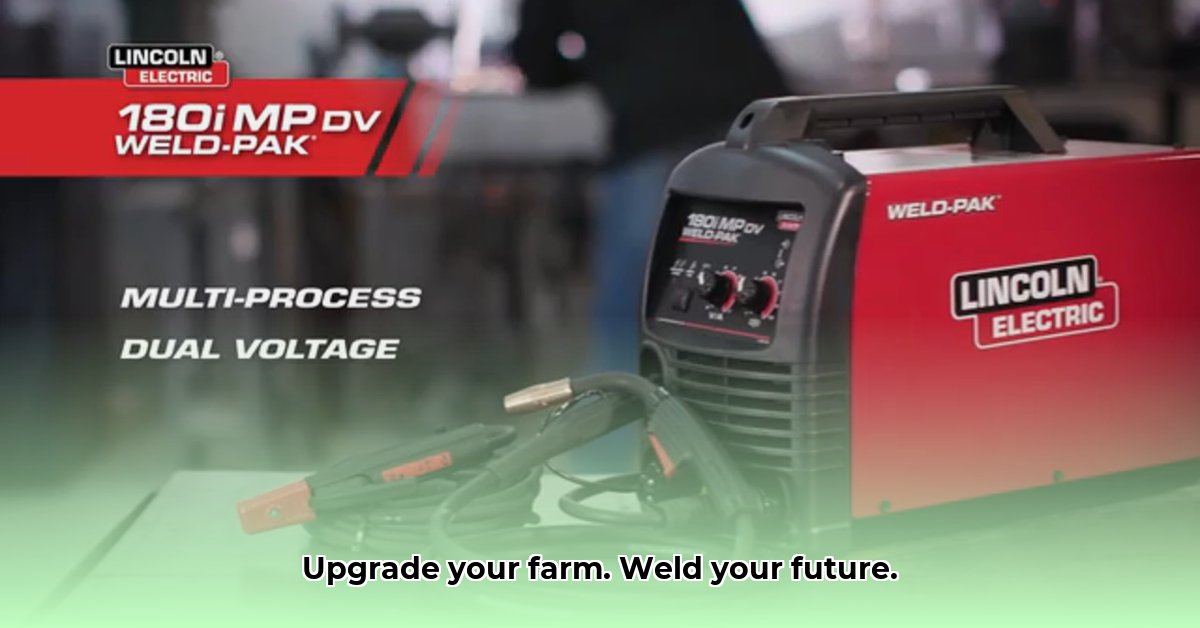
MIG Welders Tractor Supply: Your Guide to Sustainable Farm Repair
Keeping your farm equipment operational is crucial for profitability. Downtime translates directly to lost income. Proactive maintenance and repair skills are essential, and for many farmers, welding is a key part of that. This guide focuses on utilizing MIG welders from Tractor Supply for efficient and cost-effective farm repairs. For more on tractor implements, check out this helpful resource on 3-point tractor implements.
Assessing Your Welding Needs
Before purchasing a MIG welder from Tractor Supply, determine your specific repair needs. What materials do you typically work with? Are you dealing with thin sheet metal or thicker, heavier steel? This assessment directly impacts the selection of a welder with appropriate power and features. Tractor Supply offers a diverse range of welders to meet various needs.
Tractor Supply's MIG Welder Options
Tractor Supply provides a wide array of MIG welders, from basic models for occasional use to heavy-duty machines suited for frequent, demanding repairs. Consider these key factors when comparing options:
- Amperage (Welding Power): Higher amperage allows welding of thicker metals.
- Duty Cycle (Continuous Run Time): A higher duty cycle enables longer continuous welding sessions without overheating.
- Wire Feed Speed Adjustability: Crucial for consistent, high-quality welds.
- Portability: Opt for a lighter model for easy maneuverability across your farm.
Always check customer reviews before purchasing. Other farmers' experiences provide invaluable insights. Have you considered the long-term cost savings of repair versus replacement? How much downtime could you avoid with this investment?
Advantages of Owning a MIG Welder
Investing in a MIG welder offers several compelling advantages:
- Cost Savings: Repairing equipment is significantly cheaper than purchasing replacements.
- Increased Efficiency: Quick repairs minimize downtime, maximizing productivity.
- On-Site Convenience: Immediate repairs avoid the hassle and cost of transporting broken equipment.
- Versatility: A MIG welder proves useful for a wide array of farm repairs beyond machinery.
Choosing the Right MIG Welder: A Step-by-Step Guide
Selecting the right welder is straightforward with these steps:
- Assess Your Needs: Detail the types and thickness of metal you’ll be welding.
- Determine Your Budget: Tractor Supply offers welders across various price points.
- Review Key Features: Consider amperage, duty cycle, and portability requirements.
- Consult Customer Reviews: Thoroughly review user feedback for insights into performance and reliability.
- Make Your Purchase: Purchase through Tractor Supply's online catalogue or local store.
Maintaining Your MIG Welder
Regular maintenance extends the lifespan and optimal performance of your welder:
- Keep it Clean: Remove dirt and debris after each use.
- Monitor Wire Feed: Ensure smooth wire feed without obstructions.
- Inspect Connections: Check for loose wires or damaged components.
- Proper Storage: Store in a dry, sheltered location away from moisture and temperature extremes.
Sustainable Farming and MIG Welders: A Powerful Connection
Repairing equipment instead of constantly replacing it directly contributes to sustainable farming practices by reducing waste and conserving resources. This approach aligns with broader principles of resource management and environmental responsibility. What are the long-term environmental and economic benefits of this proactive approach?
Troubleshooting Tractor Supply MIG Welders
While Tractor Supply's MIG welders are generally reliable, some common issues may arise:
| Potential Problem | Solutions |
|---|---|
| Wire Feed Issues | Check for wire bends, obstructions, or worn feed rollers. |
| Inconsistent Welding Performance | Adjust voltage, wire feed speed, and gas flow. |
| Overheating | Ensure adequate ventilation and allow for cooling during extended use. |
Proactive maintenance is key to preventing these problems.
Financing Sustainable Agricultural Equipment Upgrades
Key Takeaways:
- Upgrading to sustainable equipment enhances farm profitability and environmental responsibility.
- Various financing options and government programs support these upgrades.
- A comprehensive business plan is vital for securing funding.
- Understanding grant and subsidy eligibility requirements is crucial.
- Long-term financial planning accounts for equipment lifespan and technological advancements.
Securing Funding for Sustainable Equipment
Sustainable agricultural equipment often carries a significant initial investment. Fortunately, several financing options exist:
- Traditional Financing: Explore agricultural lenders like Farm Credit Services and AgDirect for equipment loans and leases. A detailed business plan strengthens your application.
- Government Grants and Subsidies: Research local, state, and federal programs offering financial assistance for sustainable technologies. Eligibility criteria vary.
Government Support Programs
These programs often incentivize environmentally friendly practices like precision irrigation and reduced-till farming. They provide financial support for adopting cost-effective, innovative technologies. However, applications require careful preparation and attention to detail. Government websites and agricultural extension offices are excellent resources.
Maximizing Your Investment
The choice between leasing and purchasing influences long-term costs and operational efficiency. Leasing might be suitable for rapidly evolving technologies, while loans offer ownership and potentially greater long-term value. This decision should consider the equipment's lifespan and maintenance costs. What is the typical lifespan of the equipment you're considering? How does this impact your financing decision?
Strategic Planning for Successful Funding
Follow these steps for a successful funding process:
- Assess Your Needs: Identify specific equipment upgrades for improved efficiency and environmental impact.
- Research Funding Options: Explore available loans, leases, grants, and subsidies.
- Develop a Comprehensive Business Plan: Outline your investment, projected return on investment (ROI), and repayment strategy.
- Compare Financing Options: Analyze interest rates, repayment terms, and eligibility criteria from multiple lenders.
- Submit Funding Applications: Complete and submit applications, ensuring all required documentation is included.
- Monitor Progress: Track progress and maintain communication with lenders and grant administrators.
Understanding Equipment Financing for Agricultural Equipment